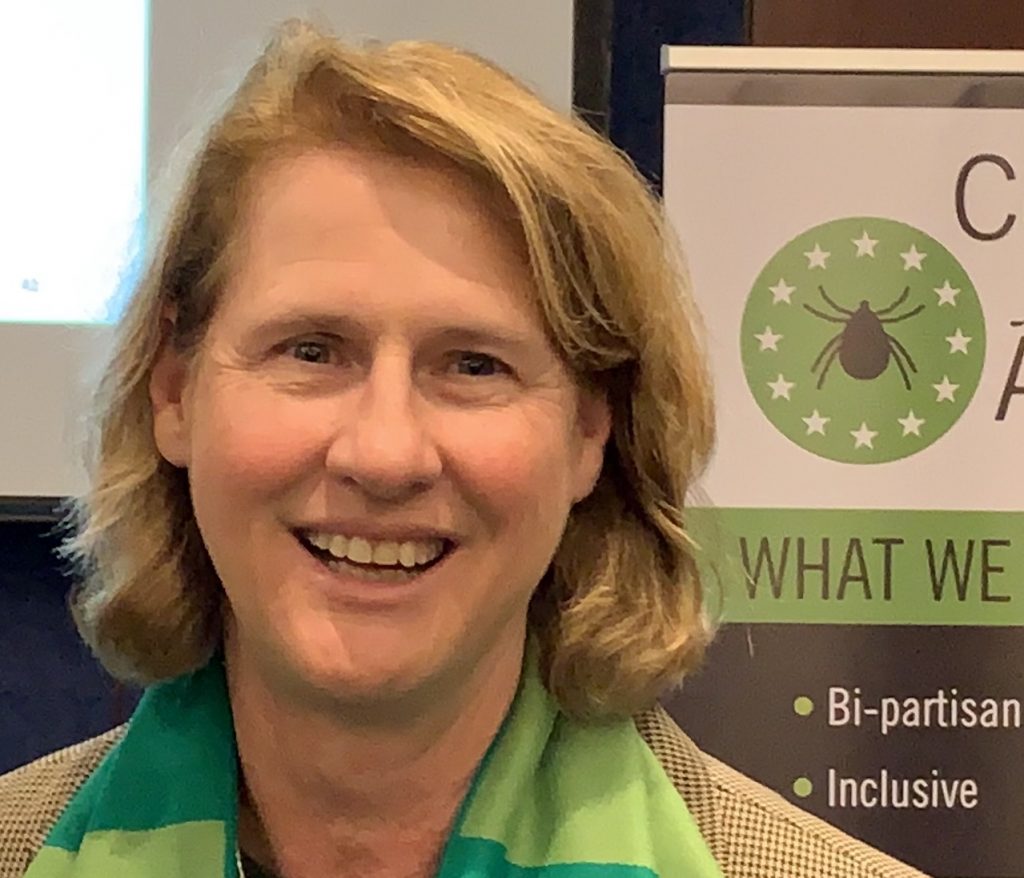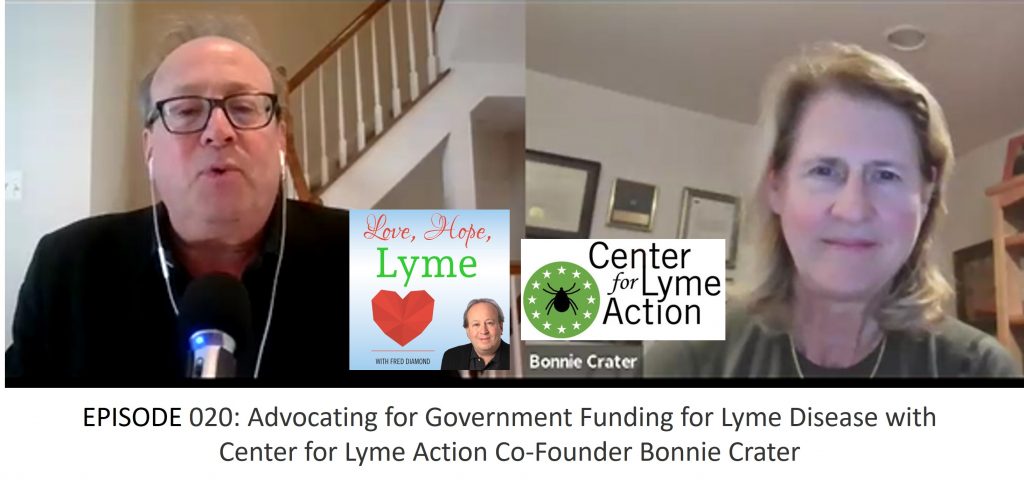PODCAST: How Lyme advocacy brings more federal funding

By Fred Diamond
On this week’s Love, Hope, Lyme podcast, Center for Lyme Action Co-founder Bonnie Crater talks about how the Lyme community can influence the federal government to provide more funding for Lyme disease research. The annual Virtual Lyme Fly-In, where people get a chance to present their case for more funding to their members of Congress, is February 20-21.
Registration to participate is open until February 10. You can register here.
When I was doing the research for my book “Love, Hope, Lyme: What Family Members, Partners, and Friends Who Love a Chronic Lyme Survivor Need to Know” to understand what someone in my life was going through, I had no idea that there were political issues with the disease.
I ignorantly presumed that Lyme and tick-borne illnesses were getting funded at the level other major diseases, such as cancer, were. The Center for Lyme Action is leading the way in making government agencies and elected officials more aware of tick-borne diseases so that more funding for diagnostics and treatment can be appropriated.
Why federal funding is critical
The Center for Lyme Action was started in 2019 to grow federal funding for Lyme and other tick-borne diseases. Crater co-founded it with her brother Jeff Crater to grow federal funding for Lyme disease. Presently, it’s at $178 million and the goal is to grow to $500 million to a billion dollars a year.
“Over $50 billion is spent every year by the federal government on research for cancer and other more well-known diseases,” she said. “The funding for Lyme and tick-borne disease is pitifully small in comparison. For us to make progress, a community of not just Lyme advocates, but doctors, researchers, people that could help us solve our problem, need that money. There’s no way that they can run a lab and do this important research without that kind of funding.”
“The lobbying for cancer started in the 1930s. We started in 2019, so we’re just at the beginning of our journey here,” she said. “We want a great diagnostic, and we want a cure right now. But step by step, we’re making a lot of progress.”
Four main areas of government focus
Ms. Crater said there are four main areas where the Federal Government is paying attention to Lyme and other tick-borne diseases and has programs and funding for research.
“The National Institutes of Health (NIH) is the largest funder of Lyme disease research in the world. The NIH has a division, the National Institute of Allergy and Infectious Disease (NIAID), which is also the division that would pay attention to things like COVID. They had been funding Lyme diseases for well over $100 million.”
The second largest funder is the Centers for Disease Control and Prevention (CDC). It plays an important role in creating awareness and tracking disease penetration. A big portion of the work that they do is also in prevention which includes funding projects which would create tick repellents, for example.
“The actual counting of the cases and keeping track of who has it and who doesn’t have it is challenging because we don’t have a good diagnostic,” she said.
The Department of Defense also has a very big interest in Lyme and tick-borne disease.
“Servicemen and women are out there crawling in the grass and the bushes as part of their training. Some of them are getting these illnesses which are very puzzling and very devastating for the training of our armed services. It doesn’t make economic sense for the government to spend money on that training when they must medically retire people who are getting ill from the training that they’re doing.”
Listen to my podcast with Nicole Malachowski for a real-world example of this here.
Fourthly, there’s a group inside the Department of Health and Human Services called Lyme Innovation. They have a program called LymeX, which is running an important diagnostic competition that is inspiring dozens of researchers and groups to win a prize for building a diagnostic that will work reliably for acute Lyme.
Virtual Fly-In on February 20-21
Ms. Crater said the Virtual Fly-In is the mechanism used to kick off the appropriations process, Last year, there were representatives from 46 states holding hundreds of meetings between Lyme advocates and their members of Congress, with the purpose of growing the federal funding for these various programs.
Ms. Crater said the Center for Lyme Action provides training on what to say, what the asks are, and the requests that need to be made. They also submit the actual appropriations requests to members of Congress. This constituent form-filling-out process is the first step. The members of Congress typically do not take any steps unless they have input from their constituents.
Why you should join the Lyme Fly-In
On the podcast, she discussed the role they take in identifying the various appropriation bills that should be funded. The first step is to make members of Congress, in both the House and the Senate, aware of the needs to grow federal funding for Lyme disease.
She said, “It’s really a matter of awareness and having a well-organized conversation with your member of Congress to explain to them the suffering that’s happening, the fact that we don’t have a good diagnostic or a therapy for people with the chronic condition, and just making them aware of that.”
On the podcast, she gave some great examples of how getting involved can lead to success. One was with Senator Susan Collins from Maine, who represents one of the most endemic states in the country.
“We held an event in October of 2019, and one of Senator Collins’ staff members was in the audience. Senator Collins was very interested in putting together a bill that would help generate more [Lyme-related] activity in the government. They called that bill the ‘Tick Act.”
The bill needed support from many senators and the Center for Lyme Action was able to find 33 co-sponsors of the bill.
“Because we had Lyme advocates from all over the country making phone calls and sending emails, we were able to get a lot of co-sponsorship,” Ms. Crater said.
“In the end, that bill passed in record time. We started working on it in October, and it became law by the end of the year. That never happens. It typically takes years for a bill to pass. But we were able to create a lot of momentum because of the fantastic work of the advocates.”
Register to participate in the Fly-In here.
Click here to listen to all episodes of the Love, Hope, Lyme Podcast or on YouTube.
Fred Diamond is based in Fairfax, VA and can be contacted via Facebook. His popular book, “Love, Hope, Lyme: What Family Members, Partners, and Friends Who Love a Chronic Lyme Survivor Need to Know” is available on Amazon. The e-version of the book is always free to Lyme survivors. Send Fred a private message on Facebook for your copy.





















We invite you to comment on our Facebook page.
Visit LymeDisease.org Facebook Page